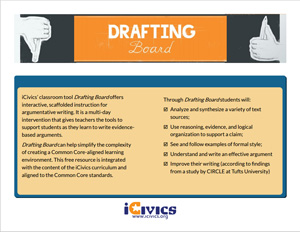 Supporting students in their development as writers of persuasive essays can be a difficult task. There are many aspects to writing a good essay. Students need to learn how to develop a good argument, find information to support their ideas, think about alternative points of view, and do all this in a clear and structured essay.
Supporting students in their development as writers of persuasive essays can be a difficult task. There are many aspects to writing a good essay. Students need to learn how to develop a good argument, find information to support their ideas, think about alternative points of view, and do all this in a clear and structured essay.
iCivics is a worthwhile collection of online games, lesson plans, and other resources for teaching civics to middle school students. One of their resources, Drafting Board, scaffolds students’ learning to write well-constructed and well-supported essays by pulling together information from a variety of sources. There are seven civics-related topics from which to choose. The website makes it clear that this is a teacher-guided activity that works best when the teacher is available to answer questions and provide other assistance as needed.
The basic framework of each Drafting Board topic includes:
- Background—Helps students to develop background knowledge on the subject and begin to form an opinion. Students are provided various sources to read and from which to pull information to complete a fill-in-the-blank narrative.
- Claim Creator—This step in the process leads students to develop their point of view on the subject and to create the thesis for their argument.
- Paragraph Constructor—Using the resources introduced in the building background module, students are led to develop three body paragraphs supporting their point of view.
- Critic Crusher—This section gets students to consider alternative points of view and how to rebut them for an effective argument.
- Introduction & Conclusion Builder—Helps students learn to build effective introductions and conclusions. This is best done after writing the body paragraphs.
A number of supports are provided throughout these steps. For students who may struggle with decoding/fluency, there is an option to have most text read aloud. Each section begins with an explanation of that aspect of an essay and a list of the steps the student will encounter. In addition, students are shown how to use transition words effectively. Finally, at the conclusion of writing each paragraph, students are given a checklist to analyze their writing. These latter three supports, as well as the overall process, provide rich “scripts” that can help students when they are more independently writing.
As literacy educators, we are well acquainted with the gradual release of responsibility model for teaching students new skills and strategies. Drafting Board is a great example of the use of this model, with the default mode being an example of gradual release of responsibility in miniature. For the first body paragraph, students are led through the process with simple fill-in-the-blank steps called “auto-complete.” Students click on appropriate support in one of the resource texts, and it fills in the sentence in the paragraph. In the second body paragraph, students are asked to write their own text to complete sentences. In the third body paragraph, students are helped to write the introductory sentence, but then guided to write the rest of the paragraph on their own. There are five additional challenge levels that each provide a different approach to scaffolding students’ writing, from providing a lot of support to providing just a little.
My seventh-grade students worked through three of the different Drafting Boards. Then we researched the case of Korematsu v. the United States and the United States’ internment of Japanese Americans during World War II. Students then wrote a persuasive essay about the Supreme Court’s decision in that case following the format they learned through Drafting Board. The following year, I noticed that some of these students carried over what they learned about the structure of an essay, the construction of introduction and conclusion paragraphs, as well as the use of transition words in the writing they did that year. The scaffolding of Drafting Board was a valuable means to help these students learn how to write an effective persuasive essay and learn a little civics, too.
 Eric MacDonald teaches in the middle school at Benchmark School in Media, PA.
Eric MacDonald teaches in the middle school at Benchmark School in Media, PA.